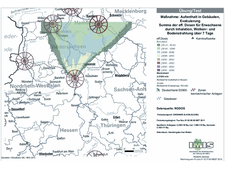-
Topics
subnavigation
Topics
Electromagnetic fields
- What are electromagnetic fields?
- Static and low-frequency fields
- Radiation protection relating to the expansion of the national grid
- High-frequency fields
- Radiation protection in mobile communication
Optical radiation
Ionising radiation
- What is ionising radiation?
- Radioactivity in the environment
- Applications in medicine
- Applications in daily life and in technology
- Effects
- What are the effects of radiation?
- Effects of selected radioactive materials
- Consequences of a radiation accident
- Cancer and leukaemia
- Genetic radiation effects
- Individual radiosensitivity
- Epidemiology of radiation-induced diseases
- Ionising radiation: positive effects?
- Risk estimation and assessment
- Radiation protection
- Nuclear accident management
- Service offers
-
The BfS
subnavigation
The BfS
- About us
- Science and research
- Laws and regulations
- BfS Topics in the Bundestag
- Links
Accident management analysis: Consequences for Germany
- After the accident of Fukushima the Federal Office for Radiation Protection (BfS) calculated the consequences in Germany after an accident like Fukushima in a German Nuclear Power Plant. The detailed report was published end of February 2015.
- The results of the BfS were installed in a recommendation of the SSK, which recommends an extension of the previous planning zones for the emergency response in the area of nuclear power plants.

![]() Effective dose for adults due to external radiation and inhalation for 30 days based on the meteorological data for December 2010. It was assumed in the simulation that a German nuclear power plant releases radioactivity for 15 days
Effective dose for adults due to external radiation and inhalation for 30 days based on the meteorological data for December 2010. It was assumed in the simulation that a German nuclear power plant releases radioactivity for 15 days
Shortly after the accident of Fukushima the Federal Office for Radiation Protection (BfS) calculated the consequences in Germany after an accident like Fukushima in a German Nuclear Power Plant. The results were given in a BfS-Report (BfS-Bericht-SW-11/12). Furthermore, BfS calculated more than 5000 case-studies between autumn 2012 and end of 2013.
The detailed report was published end of February 2015 (BfS-Bericht BfS-SCHR-55/14).
Simulation of nuclear accidents in German Nuclear Power Plants
The simulations of BfS for severe nuclear power plant accidents were performed with the RODOS decision support system. Considered were long-term releases, up to now not taken into account for planning items.
For receiving deeply profound information three different Nuclear Power Plants were chosen (Unterweser, Grohnde und Philippsburg). They are representative for different regions, like mountains, valleys, flat areas and climatical zones.
Calculation with different release scenarios and weather conditions
Several release scenarios with different source terms representing severe accidents were used in the study. The scenarios chosen for the study belong to the highest level 5, 6 and 7 (major accident) on the international INES scale for the rating of nuclear and radiological events. Based on this releases for the calculations real weather data of German Weather Service (DWD) were used and a free chosen period of 365 days (November 2011 to October 2012) were selected.
Solid statements for possible radiological results are now available. They base on the huge amount of more than 5000 calculations.
Results
For about 1,100 case studies the highest accident category INES 7 was adopted. Following results are given:
- Acute radiation damage can be avoided by prompt evacuation - before the start of the radioactive release - within about 5 kilometers.
- Up to a distance of about 20 kilometers from the plant intervention levels for evacuation may be exceeded and the intake of iodine tablets have to be taken into account.
- Up to a distance of about 100 kilometers, the intervention for
"sheltering"
may be achieved. - The implementation of iodine prophylaxis for children and young people and pregnant women may be required up to at least 200 kilometers in the direction of the cloud.
This mentioned results of the BfS are now installed in recommendation of the SSK, which recommends an extension of the previous planning zones for the emergency response in the area of nuclear power plants. They were adopted in February 2014 and the Federal Environment Ministry (BMU) forwarded them to state authorities for further planning.
This planning radii are to be extended as follows:
- evacuation from 10 kilometers to 20 kilometers radius,
- sheltering from 10 kilometers to 100 kilometers,
- distribution of iodine tablets for adults from 25 kilometers to 100 kilometers,
- distribution of iodine tablets to children, adolescents and pregnant women from 100 km to whole Germany.
Even outside the specified radii planning protective measures may be necessary in rare cases, this would be taken in addition at a nuclear accident needed.
State of 2018.06.27


